
How to Create a Review Website: Complete Guide for Businesses
Ever found yourself checking reviews before buying something online? Of course you have – we all do it.
Now imagine, what if you have your review website where people rely on your opinion to help choose the right products? Whether you are already blogging, running a business, or simply looking to create some additional income through affiliate marketing, a review website can be a smart option to build your reputation and increase your sales.
If you’ve ever wanted to turn reviews into something valuable, not just for others, but for your brand too, this blog is for you. We’ll walk you through every step of how to create a professional review website, even if you’re a complete beginner.
From choosing your niche and setting WordPress to display reviews and driving traffic, whatever you want is here.
Let’s dive in and help you create a review platform that people really trust.
Why create a product review website?
Before we proceed with the detailed steps, let’s clarify what we’re building here. What’s actually a review website?
It’s pretty straightforward – a review website is where people go to read what others think about products or services before they buy. You know how you always check reviews on Yelp or Google before spending money? That’s exactly what we’re creating.
You might want to earn some affiliate commissions, need your business to get noticed, or want everyone trusts for product recommendations. Whatever your goal is, you’re basically giving people what they want to see before buying – real opinions from people who’ve used the stuff they’re considering buying.
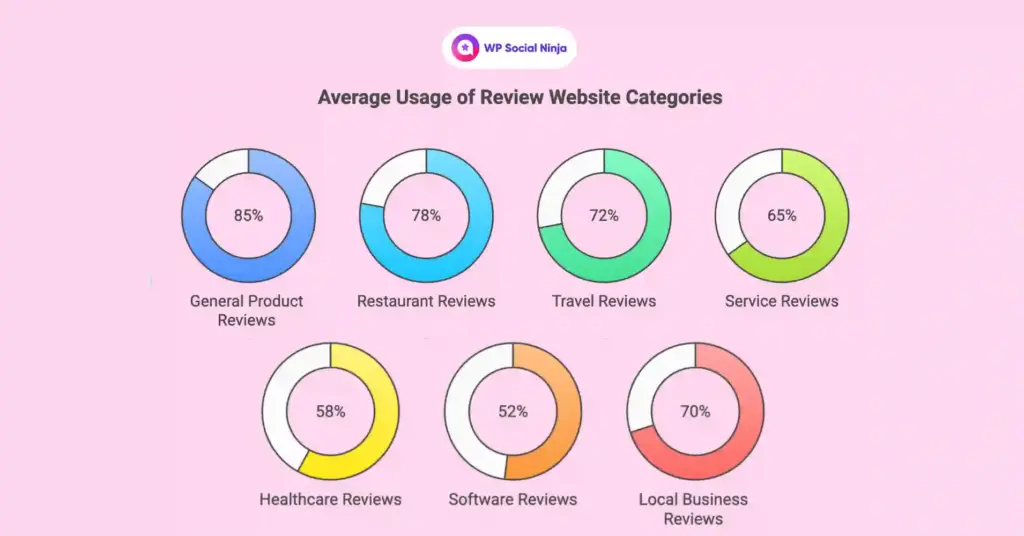
Let us dig deeper and know why your business should invest time and resources in creating a product review site for your business:
Builds trust and credibility with potential customers
According to Brightlocal, 49% of consumers rely on online reviews, as much as personal recommendations from friends or family. It is powerful.
If your website displays authentic customer experience through star ratings, reviews or video reviews, it gives visitors a reason to rely on your product or service.
Real world example: Sites such as Trustpilot (with more than 1 billion reviews) and G2 (hosting more than 2 million software reviews) have become a billion-dollar business by creating transparency among buyers and vendors. In 2023, Trustpilot’s revenue increased from $ 173.3m to $ 225.8m, while G2’s estimated annual revenue is around $ 204.6m, and it affects millions in annual software purchases, as they solved the trust gap in online commerce and provide immense value to users.
Increases conversion rates with social proof
Once the trust is built, the review becomes a powerful motivation for action. When new customers see others recommending a product or service, it significantly reduces their confusion and encourages them to shop.
This phenomenon, known as social proof, is a main psychological driver in online commerce. According to the Speigel Research Center, displaying product reviews can increase the conversion rates up to 270%.
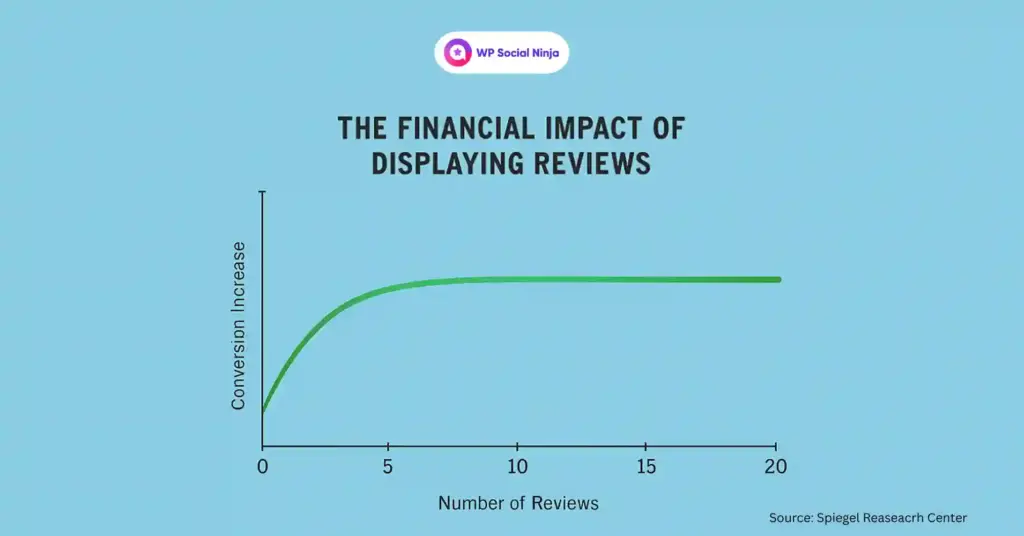
Adding online reviews to the product pages increases the conversion rates by 354%, and the visitor drives 446% more revenue, compared to pages without reviews, according to Bazaarvoice data. This means that simply displaying customer feedback can more than triple your sales.
Creates additional revenue streams through affiliate marketing
A review website provides a powerful and ethical way to generate sales, especially through affiliate marketing. This model involves reviewing products or services and then providing direct links to users to buy them.
When a user clicks on your unique affiliated link and purchases, you earn a commission. This is a win: Your audience gets fair recommendations, and you get compensation for your valuable content.
Real-world influence: Wirecutter is one of the most reliable product review websites, known for its detailed and honest testing. Their team consists of experts who invest time and money in testing products in real-life conditions, such as setting up a room on fire to test safety or to create a barrier course for a robot vacuum.
They also read customer reviews and consult engineers and experts. This hands-on method builds strong trust with readers and leads to much higher sales compared to typical affiliate sites.
Establishes your brand as an industry authority
Becoming an authority means not just collecting reviews but also analyzing trends, offering practical comparisons, and promoting a community around shared interests. This deep engagement differentiates your site from generic e-commerce listings.
Yelp has become an authority for local business reviews. Whether to search for a restaurant, a plumber, or a salon, millions of users prefer visiting Yelp as a go-to platform for local recommendations and one of the best sites for reviews.
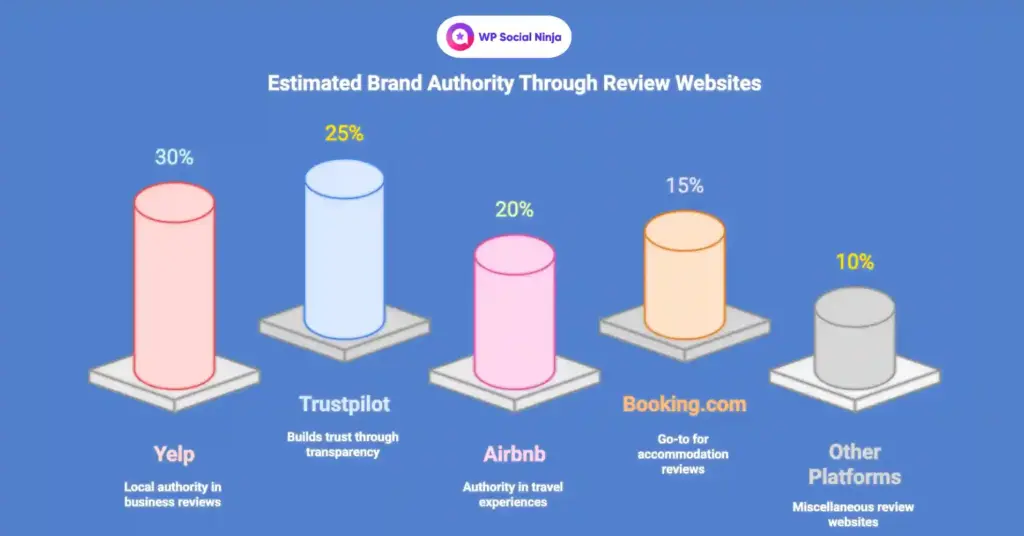
Reduces customer support inquiries with detailed reviews
This benefit is often ignored, but it has a significant impact on your operating efficiency. Comprehensive, user-related reviews usually address general questions and concerns that potential customers may have about any product or service.
When users find a detailed review on your site or directly answers within the detailed reviews or Q&A section, they are less likely to flood the chances of flooding in your customer support channels with basic inquiries.
Real-world example: Consider the strong response system of eBay. Before purchasing, customers can see detailed reviews of vendors and products, often answering questions about shipping, product status or reliability without the need to directly contact the seller.
How to build a review website? (Steps to follow)
Now that you understand the immense power of a product reviews website, it’s time to roll up your sleeves to take steps!
So, if you want to create a review platform for your business, we will break the entire process into seven managed stages. This will ensure you have a clear roadmap to launch your successful review platform.
Step 1: Define your niche & understand your audience
Before creating your review website, you have to know who you are serving. Choose a specific niche instead of going wide. For example, instead of “electronics”, focus on “Budget smartphone for students” or “Gaming laptop” under “$ 1000”.
Things you should consider:
Find your perfect niche
Choose something that you are really interested in, has decent discovery demand, but the competition is manageable. Do research using Google Trends and check if there are related programs or modification opportunities available.
Understand your audience
Create a detailed picture of your ideal reader. What problems do they face? What is their budget limit? Are they technical-loving or beginner? Connect with Facebook groups, Reddit communities, and forums where your target viewers discuss products.
Research that works
Read comments on competitive sites and YouTube videos in your niche. Look for general questions, complaints, and what people want. This shows you exactly what content gaps you can fill.
With a clear niche focus and deep audience understanding, you’ll create a review website that actually helps people to make decisions.
Step 2: Plan your website structure, features & user experience
Before diving into the technical setup, it is important to plan your review website properly. A strong structure not only improves user experience but also helps to create confidence and keep visitors engaged.
Here’s how to do this:
Decide on your website pages
Start by planning the pages your site will require. These are the main pages that visitors expect when they visit a website:
- Home: A must-have page that gives a quick overview of your website, featured reviews, and calls to action.
- About: Share your story, mission, or what makes your reviews trustworthy.
- Reviews: Though you can keep your reviews on different pages, you can still make a dedicated page for it. You can make a central hub where all your reviews are listed, possibly categorized by product type.
- Products or Categories: To give all information from your website, you need dedicated pages for different products, services, or niches.
- Pricing (if offering services): Show pricing tiers or affiliate offers, and short glimpses for each pricing plan.
- Contact: A simple way for users, brands, or visitors to reach you.
If you want to allow users to submit reviews, you can add a “Submit Review” or “Write a Review” page as well.
Include core features that improve usability
The right features can take your site from basic to brilliant. Consider including:
- Star Rating System: Helps users quickly understand the product’s performance at a glance.
- Filterable Categories: Allow users to filter by brand, product type, rating or price range.
- Search Bar: Makes it easy for users to find specific reviews or subjects.
- User Profiles (Optional): Allow registered users to leave reviews, track submissions, and build a community.
- Comment Section: Encourage discussions and feedback under each review.
These features improve navigation, boost interaction, and help users trust your site more.
Focus on clean design & easy navigation
User experience (UX) can create a good impression for your website. Also, it can break your website. So, design with clarity in mind:
- Use intuitive menus and simple page layouts to prevent users from getting lost.
- Ensure your font size, colors, and content blocks are easy to read and scan.
- Include breadcrumbs or category tags so users always know where they are on your site.
Don’t ignore mobile accountability and speed. More than 60% of users browse on mobile, and Google factors site speed into its ranking.
Step 3: Choose the right platform
For most user review sites, WordPress.org (self-hosted) is the top option. It is flexible, easy to use, and supported by a large-scale plugin ecosystem.
- Why WordPress? Your design and SEO have complete control, and it is cost-effective.
- Other options: Squarespace and Shopify support review features, but the plugin for advanced adaptation lacks flexibility.
Step 4: Setting up your website with Hosting, Domain
Your domain name and hosting service form the foundation of your review website’s online presence. A well-chosen domain builds trust while reliable hosting ensures fast loading and accessibility.
So, let’s see how you can make your site online and prepare for the content.
For choosing the perfect domain name, consider these:
Brand and Memorability: Keep it simple, memorable, and easy to spell – avoid hyphens, numbers, or complex spellings. Consider how it feels when it is spoken loudly, and think beyond just reviews for future development capacity.
SEO and Marketing: Include keywords like “review” or your niche for SEO benefits, but don’t sacrifice brand identity. Keep domains under 15 characters and make sure that they match the usernames of your social media handles.
Technical and Legality: Stick with .com for credibility; .org works well for review sites. Check domain history using Wayback Machine to avoid spam-associated domains. Search the USPTO database to avoid trademark conflicts and have 3-5 backup options ready.
Also, for selecting a reliable hosting, consider these:
Performance Requirements: Choose hosting that handles quality image content and traffic spikes with fast SSD storage and CDN support. Look for WordPress-optimized hosting solutions for better performance.
Required features: Ensure automatic backup, SSL certificate, 99.9% uptime guarantee, and easy WordPress installation. Include a staging environment for development and scalable resources for growth.
Recommended option: Start with shared hosting from Bluehost, Siteground, or WP Engine for budget-friendly reliability. Upgrade VPS or dedicated hosting as traffic grows.
Security compulsory: Apply regular backup, malware scanning, and automatic updates. Enable domain privacy protection and choose hosts offering comprehensive security features to protect your website content.
Step 5: Select a WordPress theme
Once you install WordPress, in the next ste,p you can work on making your website attractive. Your WordPress theme is the view and functional backbone of your review website.
It determines how your content displays, how users navigate your reviews, and how efficiently you can manage your site. The correct theme streamlines your workflow with pre-built review layout, rating system, and comparison tables, while quickly loading your site and ranks well in search results.
You can check our suggestions on the top review themes to set up your review website:
1. REHub: Explicitly designed for affiliate marketers and review sites that prioritize conversions:
- Advanced comparison tables and versus layouts.
- Built-in price tracking and deal alerts.
- Multiple review formats (pros/cons, ratings, video reviews).
- Affiliate link cloaking and management tools.
- WooCommerce integration for selling your own products.
- Social proof features like user voting and comments.
- Coupon and deal posting capabilities.
2. Astra: Great for custom review sites requiring maximum flexibility, which provides:
- Pre-designed review website starter templates.
- Page builder compatibility (Elementor, Beaver Builder).
- Speed-optimized lightweight code.
- Thousands of customization options.
- Excellent customer support and documentation.
3. MyReview: Specifically designed for review and rating websites, which have:
- Comprehensive review and rating system.
- User-generated review capabilities.
- Advanced filtering and search options.
- Monetization-ready with affiliate link integration.
- Mobile-optimized review layouts.
Also, there are more WordPress review themes you can check out, like Blocksy (fast and flexible theme with review capabilities), MyReview (Designed exclusively for review websites), WP Review (Clean and focused review theme).
Step 6: Install a WordPress review plugin
To make your review website complete, you need social proof. If you want to bring all your social proof from different review platforms, you might need to fetch and display those reviews manually. But with a review plugin, you can do this in no time.
You can use WP Social Ninja, a comprehensive social proof solution that displays reviews from 10+ review platforms like Google Business Profile, Facebook, Yelp, and others.
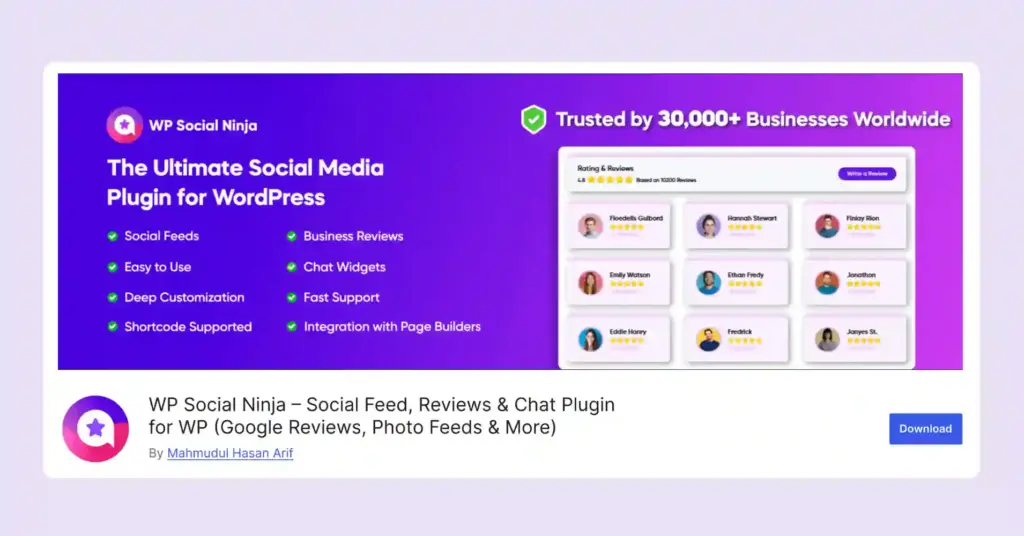
You can easily create personalized review templates and add them to the pages of your site where you want to show your customer reviews. From connecting your account to displaying your reviews, you won’t need any coding skills, but you have to follow some steps.
Let’s have a look at how dedicated review plugins can help you:
Increases reliability: Review plugins let you show the real customer response, which creates a quick trust.
Easy review management: Collect, filter, and showcase reviews from several platforms in one place.
Customization option: Match the review layout with your brand using design and layout options.
Automatic review collection: Most of the plugins help you collect and display reviews automatically.
Supports several platforms: Collects reviews from Google, Facebook, Yelp, and more without manual work.
Schema Snippet: Adds detailed business information for rich snippets in search results.
‘Write a review‘ button: Allow visitors to write their reviews. In addition, you can add a custom URL to the CTA to redirect your customer on a separate/specific review site.
Language-specific reviews: Review in specific languages from TripAdvisor and Booking.com for target audiences.
Optimize review images: Automatically improves review images for better performance quality and preview.
GDPR compliance: Ensures all review data collection and performs the privacy rules.
Multiple business accounts: Connect and display reviews from different business accounts in one place.
Rating filter: Filter by star rating to show only your best reviews for visitors.
AI overview: Get a quick summary and insight from all your collected reviews with AI review summarizer.
Advanced styling option: Professional design options to make your review template match your website perfectly.
Import/Export review: Easily transfer custom reviews between sites or back up your review data.
Win your customers’ hearts with exceptional features
Discover how WP Social Ninja can assist you in designing outstanding customer experiences.

All these advanced features are packed in WP Social Ninja, to make it your entire review management solution. In the next step, we will show you how to set it up and start using these features on your website.
Step 7: Add a review page on the website
As you know, the social proof plugin we introduced allows you to connect multiple platforms to display reviews. Let us show you an example of how to add reviews to a website using this tool.
If you want to know how to add Google reviews, here’s how you can do it:
Get started: Head over to your WordPress dashboard and click on Plugins, then Add New. Type “WP Social Ninja” in the search bar, install it, and hit activate.
Connect your Google Business Profile: Once you’ve got the plugin running, you’ll see WP Social Ninja in your dashboard. Click on it, then go to Social Reviews and select Google. You’ll need to connect your Google account here – just follow the prompts, and you’re all set.
Make it look good: This is where you can have some fun. The plugin gives you different ways to show off your reviews – you can go with a clean grid layout, a sliding carousel, or even a Pinterest-style masonry look. Play around with the colors and styling until it matches your website’s vibe.
Getting it live: The final step is actually putting those reviews on your site. The plugin will give you a shortcode that you can copy and paste into any page or post.
Want them on your homepage? Perfect. Thinking about a dedicated reviews page? Even better. You can also stick them in your sidebar if that works for your layout.
That’s it – your Google reviews are now working for you around the clock, showing visitors that real people love what you do.
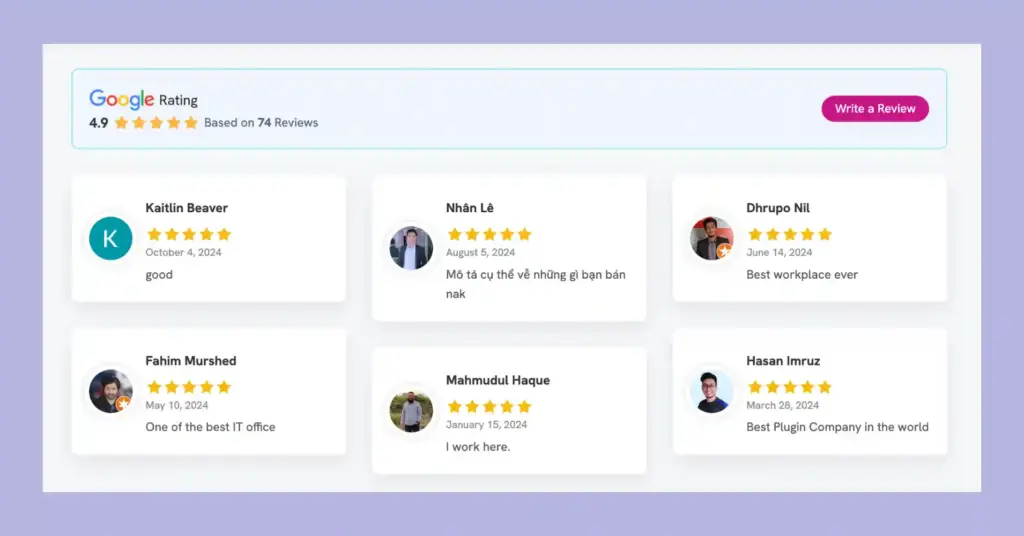
Also, if you want to know how to add a review on Google, read: How to Write A Google Review for A Business (Best Practice).
Update your review website with more social proof
Adding reviews is just the beginning. A reliable, highly converted review site aims to show social proof from every angle. WP Social Ninja goes beyond embedding reviews by offering an entire suite of features that strengthen the reliability and run the user action.
Social Feed: Besides showing social reviews, bringing active social media engagement adds another layer of trust. WP Social Ninja allows you to display social media feeds from platforms like Facebook, Instagram, X (Twitter) and YouTube directly on your website.
Social Chat: Instant communication builds instant trust. Integrating social chat widgets (such as Messenger, WhatsApp, or Telegram) through WP Social Ninja offers visitors a direct and familiar channel for visitors to ask questions, respond or receive immediate support.
Special note: To get connected with your customers through this social proof plugin, you can check – How to Add The Perfect Facebook Chat Plugin for WordPress
Notification Popup: WP Social Ninja’s notification popup lets you show small popups on your website that highlight recent customer activity, like “John reviews 5-stars for XYZ product!” These pop-ups attract attention, build confidence in new visitors, and encourage them to take action by displaying real-time social proof.
Custom reviews: Beyond importing reviews from multiple platforms, WP Social Ninja allows you to make and manage “custom reviews” on your WordPress site. You can collect feedback from different resources and showcase them in one place on your website or highlight unique user experiences that cannot be found anywhere else.
Testimonial: While reviews often focus on specific products, the detailed testimonials provide wide support for your brand or service. WP Social Ninja provides a dedicated layout and easy management to display these powerful statements.
Export/Import reviews: Managing large versions of reviews, or migrating them from another platform, may be a difficult task. WP Social Ninja simplifies it with export and import custom reviews functionality. This ensures that your valuable social proof data is always safe, portable, and easily transferable.
Also, learn: How to Add & Display Google Review Badge on Your Website
Complete your website with the best WordPress plugins
Once your review website is up and running, it is time to upgrade it with the necessary tools that improve user engagement, automate key tasks, and make managing your site easier.
To help you do this, we have mentioned here some top WordPress plugins that will work seamlessly with your review site. These plugins are not only good – they are designed to improve lead generation, community building, and customer communication.
What do we recommend here:
Fluent Forms: The ultimate Drag-And-Drop form Builder for WordPress. Whether it’s collecting user reviews, newsletter signups, or inquiries, Fluent Forms quickly handles it without coding.
FluentCRM: It’s an email marketing automation plugin. Use it to nourish customers, send review updated emails, or create automatic email sequences from your dashboard.
Paymattic: A powerful solution to accept payments, donations, or payments. Great to run your platform or donation-based projects.
FluentCommunity: This one is made for building and managing your own online community. You can create member profiles, run discussions, manage groups, and grow a safe, engaging space for your audience.
Fluent Support: A sharp, reliable customer support ticketing system designed for WordPress. Use it to manage user questions, follow up on reviews, or provide post-purchase assistance.
Together, these plugins make a solid backbone for your review site, giving you control, flexibility, and a more engaging experience for your visitors.
Now it’s your turn to build and succeed!
So far, you have gone through every necessary step to create a powerful review website by defining your niche and setting up your platforms with smart tools such as WP Social Ninja.
You’ve also seen how social proof can build trust, improve SEO, and help you earn through affiliate marketing or paid promotions. With the right plugins, such as form builders, email tools, and chat support, you can turn your site into a powerful, high-converting platform that runs smoothly.
Remember, you don’t need to be a developer or technical expert to get started. With the correct guidance and tools that we’ve mentioned in this blog, even a complete beginner can launch a professional review website in a few days.
So take the first step. Choose your niche, utilize the necessary tools your business needs, and bring your idea to life – your successful review platform is a few clicks away!
FAQ
How do you collect customer reviews?
You can collect customer reviews in a few easy ways. You can add a review form to your website, send follow-up emails after a purchase, or use social reviews tools like WP Social Ninja to pull reviews from Google, Facebook, Yelp, WooCommerce, and more.
How to get more Google reviews?
Ask satisfied customers to leave a review by sharing your Google review link. Make the process simple by sending follow-up emails or adding a Google review button on your website or checkout page. To know more, you can read the blog on how to get reviews on Google.
What’s the best way to make a website for a small business?
To create a website, you do not need a big budget and a team to handle it. Rather, you can do it without wasting your time, money, and lots of research. Use a user-friendly WordPress theme and necessary plugins such as WP Social Ninja, Fluent Forms, and Paymattic. These plugins are budget-friendly and easy to manage. To know more, read: How to Create A Website Free of Cost? (Expert Picks).
How can I ensure my website appears at the top of Google searches?
Note the best practices: Use relevant keywords, publish quality content regularly, add a schema snippet, and improve the speed and mobile accountability of the site. Adding fresh customer reviews also increases the ranking.
Hridi Paul
Hridi here, a curious mind navigating the exciting world of digital marketing with 3-years of experience in content writing, copywriting, and email marketing. I love exploring the ever-evolving world of marketing and finding creative ways to connect with audiences. When I’m off the clock, you’ll often find me enjoying music or seeking serenity in nature.

Subscribe To Get
Weekly Email Newsletter
Connect, Customize, and Display Social Feeds, Reviews, and Chat widgets










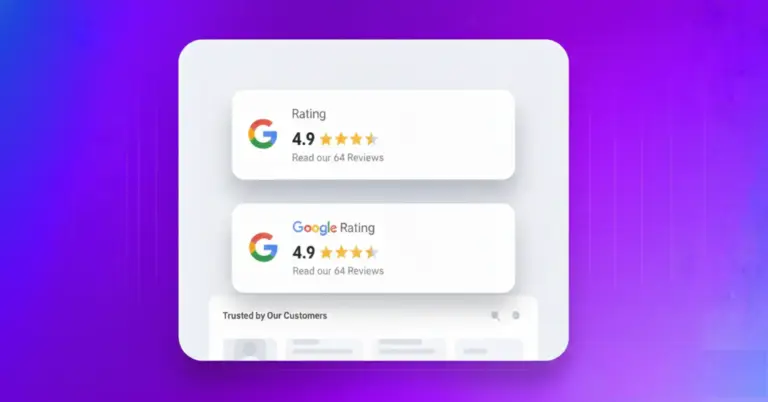









Leave a Reply